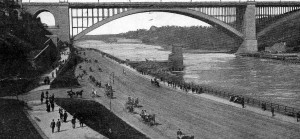NEW YORK- The renovation of the historic Highbridge, the oldest pedestrian pathway between Harlem and the Bronx, is a process that is going down in history thanks to architectural construction documentation photographer, Carlo Buscemi.
Historical documentation of the original Highbridge has allowed for the renovation of the bridge and current documentation will continue to ensure its preservation for the future. Similar to restoring an old painting, one must know the techniques originally employed by the artist in order to restore the painting.
Carlo Buscemi is the sole architectural construction documentation photographer employed by Schiavone Construction Company—the construction company that won the city’s competitive project bid. Buscemi confirms that the company is following historic preservation principles in order to restore the original architectural design. His photographs entail everything from the original untouched structure to the time lapse of the construction to the material and machinery used by workers.
“This bridge had to be documented for the government before any type of work could be done on it…which consists of 4×5 black and white film. And this whole bridge is documented through selected angles, old school style,” Buscemi said.
Buscemi is one of the few architectural construction documentation photographers he knows of. As a longtime freelancer, he is aware of his dying trade. More and more construction companies are hiring amateurs to document sites with the Iphones.
Although Buscemi is a trained photographer, having studied at Germaine School of Photography at Stony Brook University, his type of work is often seen as its own breed by fellow photographers. For accomplished Pratt educated artist and photographer, Heather Mckenna, architectural construction documentation photography digresses over content and form. “Being an artist is determining your own content, not having it already determined for you. You can have technical skill and mastery of photography, but the art lies in making expressing and emotional or intellectual message.” Buscemi sees his work as having artistic tenets, even if it is not creating content in the theoretical sense. He creatively captures what is already there.
Buscemi likens himself to famed landscape photographer Ansel Adams whose black and white photographs of Yosemite have become iconic images that document the American West. Like Adams, Buscemi’s job entails waiting for hours to capture a single image and express the scale of the structure.
“What I do…there’s no editing allowed. They have to be what’s called camera original. It’s just like film. It’s not just a question of taking pictures, it is a full documentation process,” he said. After snapping a photo with his Nikon camera, he uses an LCD viewfinder to make sure he got the perfect shot. Buscemi will wait until the historic site is deserted in either the early morning or late evenings to give have the structure on its own. Often only using natural lighting, Carlo relies on patience to note the subtle changes in light and form in a structure.
Dissimilar to Adams, who preferred to have humans void of his grandiose landscapes, Buscemi is also required to document the workers engaging with the site, the material used, and the safety regulations maintained. The photographs do not go through any editing software; they are submitted as camera raw images, preventing any bias or amplification.
The bridge is based upon ancient roman design and spans approximately 1100 feet. Originally constructed in 1848 as an aqueduct, the bridge transported water from the outer boroughs into booming Manhattan. By the early 1900s, Highbridge was considered a rugged version of Central Park, complete with a pedestrian walkway, magnificent views, and a greenway waterfront. As New York City financially struggled in the 1970s, however, the bridge was closed and the Highbridge became one of the most neglected historic landmarks in New York.
Documenting the changes to the bridge does not come without risk. Already one construction engineer, Paul Schliser, has fallen over 100 feet to his death while inspecting the old bridge, four days after construction commenced. Buscemi is one of many contractors who risk their lives daily for resurrecting historical projects like Highbridge, but his passion outweighs his fear.
“After you have done a project like this, you see people using it, you are back there somehow a part of helping this project coming into fruition,” he said.

